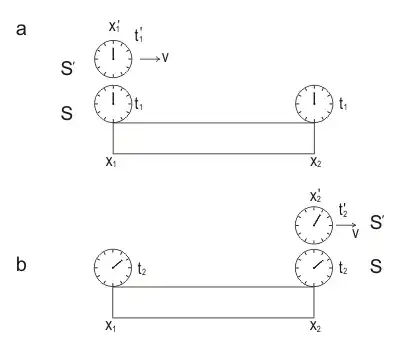The outcome depends on the method, how A (or B) measures and which clock he compares to which clock.
The problem is that A and B can only directly compare readings of their clocks when they are at the same point. If they are at some distance from each other, to say what "another clock" shows they must make some assumptions about the one-way speed of light and put another clock that is synchronized with their own clock.
Let's at initial moment A and B are at “starting position" close to each other and the both their clocks show 0.
1) Let’s A is “at rest” and B is moving. A places clock A1 at starting point and clock A2 at finish and synchronizes these clocks by a beam of light, assuming that the one – way speed of light is c. When B comes to the clock A2 he compares readings (in immediate vicinity) of his own clock with the clock A2. The clock A2 shows 60, while the clock B shows 30.
2) Let’s B is “at rest” and A is moving. B places clock B1 at starting point and clock B2 at finish and synchronizes these clocks by a beam of light, assuming that the one – way speed of light is c. When A comes to the clock B2 he compares readings (in immediate vicinity) of his own clock with the clock B2. The clock B2 shows 60, while the clock A shows 30.
Let us demonstrate time dilation of the SR in the following experiment (Fig. 1). Moving with velocity $v$ clocks measure time $t'$. The clock passes past point $x_{1}$ at moment of time $t_{1}$ and passing past point $x_{2}$ at moment of time $t_{2}$.
At these moments, the positions of the hands of the moving clock and the corresponding fixed clock next to it are compared.


Let the arrows of moving clocks measure the time interval $\tau _ {0}$ during the movement from the point $x_ {1}$ to the point $x_ {2}$ and the hands of clocks 1 and 2, previously synchronized in the fixed or “rest” frame $S$, will measure the time interval $\tau$. This way,
$$\tau '=\tau _{0} =t'_{2} -t'_{1},$$
$$\tau =t_{2} -t_{1} \quad (1)$$
But according to the inverse Lorentz transformations we have
$$t_{2} -t_{1} ={(t'_{2} -t'_{1} )+{v\over c^{2} } (x'_{2} -x'_{1} )\over \sqrt{1-v^{2} /c^{2} } } \quad (2)$$
Substituting (1) into (2) and noting that the moving clock is always at the same point in the moving reference frame $S'$, that is,
$$x'_{1} =x'_{2} \quad (3)$$
We obtain
$$\tau ={\tau _{0} \over \sqrt{1-v^{2} /c^{2} } } ,\qquad (t_{0} =\tau ') \quad (4) $$
This formula means that the time interval measured by the fixed clocks is greater than the time interval measured by the single moving clock. This means that the moving clock lags behind the fixed ones, that is, it slows down.
Every observer repeats the same procedure.
The animation below demonstrates change of frames and time dilation:

Time of "stationary" observer is the same (universal) in the whole frame and evenly distributed across the whole frame. So, when some answers mean, that B is not younger, but surprisingly older, they are in some sense correct, because they mean time of the whole reference frame, in which A moves. The stationary observer "occupies" the whole frame. Time in the "stationary" reference frame B runs faster than the time of the single moving clock A; Time in the "stationary" reference frame A runs faster, than the time of the single moving clock B.




